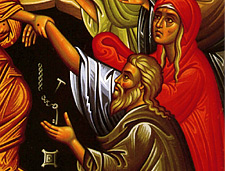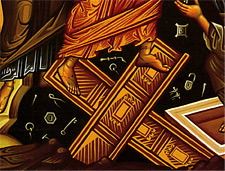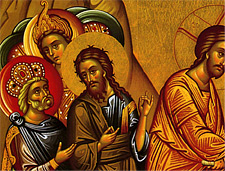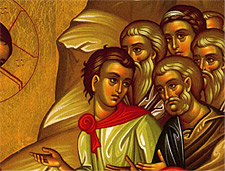SOURCE: lent.goarch.org
Introduction
On the Great and Holy Feast of Pascha, Orthodox Christians celebrate the life-giving Resurrection of our Lord and Savior Jesus Christ. This feast of feasts is the most significant day in the life of the Church. It is a celebration of the defeat of death, as neither death itself nor the power of the grave could hold our Savior captive. In this victory that came through the Cross, Christ broke the bondage of sin, and through faith offers us restoration, transformation, and eternal life.
Commemoration Of The Great And Holy Feast Of Pascha
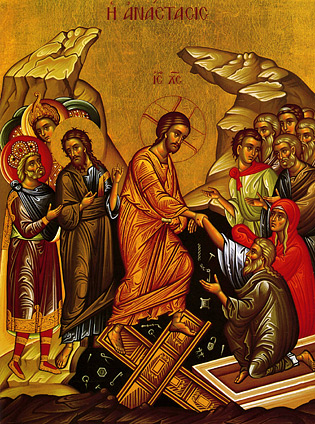 |
| Icon of the Anastasis provided by Theologic and used with permission |
The Resurrection of Jesus Christ is the fundamental truth and absolute fact of the Christian faith. It is the central experience and essential kerygma of the Church. It confirms the authenticity of Christ's remarkable earthly life and vindicates the truth of His teaching. It seals all His redemptive work: His life, the model of a holy life; His compelling and unique teaching; His extraordinary works; and His awesome, life-creating death. Christ's Resurrection is the guarantee of our salvation. Together with His Ascension it brings to perfection God's union with us for all eternity.
The Resurrection made possible the miracle of the Church, which in every age and generation proclaims and affirms "God's plan for the universe, the ultimate divinization of man and the created order." The profound experience of and the unshakable belief in the risen Lord enabled the Apostles to evangelize the world and empowered the Church to overcome paganism. The Resurrection discloses the indestructible power and inscrutable wisdom of God. It disposes of the illusory myths and belief systems by which people, bereft of divine knowledge, strain to affirm the meaning and purpose of their existence. Christ, risen and glorified, releases humanity from the delusions of idolatry. In Him grave-bound humanity discovers and is filled with incomparable hope. The Resurrection bestows illumination, energizes souls, brings forgiveness, transfigures lifes, creates saints, and gives joy.
The Resurrection has not yet abolished the reality of death. But it has revealed its powerlessness (Hebrews 2:14-15). We continue to die as a result of the Fall. Our bodies decay and fall away. "God allows death to exist but turns it against corruption and its cause, sin, and sets a boundary both to corruption and sin." Thus, physical death does not destroy our life of communion with God. Rather, we move from death to life - from this fallen world to God's reign.
Icons Of The Commemoration Of Great And Holy Pascha
 |
| Icon of the Resurrection provided by Theologic and used with permission |
One of the most symbolic of the Festal Icons of the Orthodox Church is that of the Holy Resurrection. In the center of this radiant event is Christ pulling Adam and Eve up from their tombs. The gates of the Realm of Death are broken and thrown down. Death, personified in human form is defeated, and bound hand and foot at the bottom of the scene. We recall the joyous words of St. Paul: "O death, where is thy sting? O grave, where is thy victory?" (1 Corinthians 15:55)
|
|
||||
In the background stands the host of the departed, so numerous they can not be depicted. Among them in the front of the multitude are some of the righteous dead, though now invigorated by the Resurrection. King David and his son Solomon are seen on the left wearing crowns. Near the center is Saint John the Baptist. On the other side is Abel, the son of Adam and the first man to ever die. He wears a shepherds robe and has a cane. Many Icons of this subject depict large crowds with a few other recognizable prophets.
|
|
||||
Orthodox Celebration Of Pascha
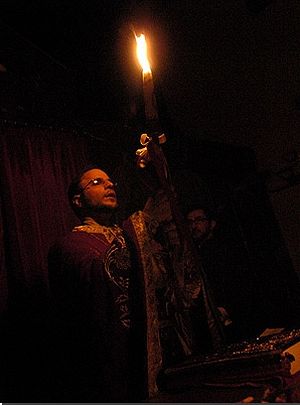 |
| Photo courtesy of John Thomas and used with permission. Experience more of Holy Week in pictures through John Thomas' book "Sacred Light: Following the Paschal Journey" |
Then comes the breathless moment as the people wait for the priest to start the hymn of Resurrection, which they join him in singing, repeatedly: "Christ has Risen from the dead, by death trampling upon Death, and has bestowed life upon those in the tombs". From this moment the entire service takes on a joyous Easter atmosphere. The hymns of the Odes and Praises of Resurrection which follow are of superb meaning and expression. The people confess, "It is the Day of Resurrection, let us be glorious, let us embrace one another and speak to those that hate us; let us forgive all things and so let us cry, Christ has arisen from the dead". By this hymn they admit that love of one's fellowman is the solid foundation of the faith in the Resurrection of Christ.
The Divine Liturgy of Saint John Chrysostom is then officiated. At the end of the Liturgy, a part of the marvelous festival sermon of Saint Chrysostom is read, which calls upon the people to "Take part in this fair and radiant festival. Let no one be fearful of death, for the death of the Savior has set us free . . . O Death, where is thy sting? O Hades, where is Thy victory? Christ is Risen and Thou art overthrown. To Him be glory and power from all ages to all ages."
The Scripture readings for the Divine Liturgy are: Acts 1:1-8 and John 1:1-17.
On Easter Sunday afternoon the faithful gather once more for prayer with lighted candles. All sing the hymn, "Christ is Risen from the Dead". The people greet one another joyously, saying: "Christ is Risen", the Easter salutation which is answered, "Truly He is Risen". They sing, "the dark shadows of the Law has passed away by the coming of grace", and standing in exaltation they exclaim, "Who is so great a God as our God?"
The Gospel according to John (20:19-25) is read in various languages, proclaiming the Good News of Resurrection all over the universe without discrimination. The fruit of faith in the Resurrection of the Lord is love in His Name; therefore, this day is called "Sunday of Agape" (love feast), a day dedicated to Christian principles, especially to forgiveness and charity. At this time, Christians seek to end misunderstanding and arguments among those whom they may be at odds. Apostle Paul firmly interprets the Resurrection of Christ, saying: "If Christ has not been raised, then our preaching is in vain and your faith is in vain" (1 Corinthians 15:14). The Church also states in its Creed, "The Third day He rose again."
Hymns Of Pascha
Apolytikion (Plagal of the First
Tone)
Christ is risen from the dead, by death trampling down
upon death, and to those in the tombs He has granted life.
Listen »
First Ode of the Canon of Pascha (First
Tone)
It is the day of Resurrection, let us be radiant, O ye
peoples: Pascha, the Lord's Pascha; for Christ God hath
brought us from death to life, and from earth unto Heaven
as we sing the triumphal hymn. Listen »
Doxastikon of the Praises (Plagal of the First
Tone)
It is the day of Resurrection; let us be radiant for the
festival, and let us embrace one another. Let us say, O
brethren, even to those that hate us: Let us forgive all
things on the Resurrection; and thus let us cry: Christ is
risen from the dead, by death He has trampled down death,
and on those in the tombs He has bestowed life.Listen »
References
Pentecostarion. Translated from the Greek by Holy Transfiguration Monastery (Boston: Holy Transfiguration Monastery, 1990), 27-42.
Calivas, Alkiviadis C. Great Week and Pascha in the Greek Orthodox Church (Brookline: Holy Cross Press, 1992), pp. 89-121.
Farley, Donna. Seasons of Grace: Reflections on the Orthodox Church Year (Ben Lomond, CA: Conciliar Press, 2002), pp. 147-152.
Wybrew, Hugh. Orthodox Lent, Holy Week and Easter: Liturgical Texts with Commentary (Crestwood, NY: St. Vladimir's Seminary Press, 1997), pp. 113-118.

